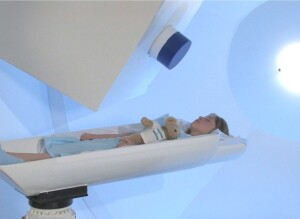by
Loren Bonner, DOTmed News Online Editor | September 20, 2012

Courtesy of Optivus Proton Therapy
More children are being treated for cancer with an advanced form of radiation therapy known as proton therapy. According to new survey findings from the National Association for Proton Therapy (NAPT) and the Pediatric Proton Foundation (PPF), 613 children were treated with proton beam therapy in 2011, an increase of 32 percent from 2010, the first year the survey was conducted.
Because proton therapy can deliver high doses of radiation noninvasively with minimal side effects, the treatment is often used to kill hard-to-reach malignant tumors in the brain, lung, head, and neck. Results from the survey found that approximately 75 percent of the children treated with protons had brain tumors.
According to a statement from NAPT, the decreased radiation dose outside the tumor is especially critical for children whose tissue is still growing. The statement goes on to say that traditional radiation in pediatric brain tumors has been associated with long-term neurocognitive deficits, including decreases in IQ and difficulties with attention.



Ad Statistics
Times Displayed: 174738
Times Visited: 3187 For those who need to move fast and expand clinical capabilities -- and would love new equipment -- the uCT 550 Advance offers a new fully configured 80-slice CT in up to 2 weeks with routine maintenance and parts and Software Upgrades for Life™ included.
Proton therapy has been around for decades but is only used in about 1 percent of all radiation therapy cases, according to Leonard Arzt, executive director of NAPT.
"We expect it to rise to five percent in the next couple of years. At the moment, there are currently 10 operating centers around the country and another 10 under construction or in the pipeline," he said.
The reported 2010 and 2011 cases were treated at nine U.S. proton centers. In the spring, New Jersey welcomed the nation's 10th center. Artz attributes the increase in pediatric treatment cases to better access as well as enhanced public awareness.
"One center tripled its cases over 2010 and many more kids from the UK [were] sent over, and other foreign countries," Artz told DOTmed News.
Although many doctors tout the benefits of this therapy, the technology is controversial due to the high costs of building treatment centers -- an investment that requires securing vast amounts of land and large sums of money, which can easily exceed $100 million.
According to Susan Ralston, executive director of the PPF, public and private insurers will cover proton therapy.
"It depends on the health care plan, of course, and often the collaboration of the child's oncologist and the proton radiation oncologist to document the benefits of proton over traditional radiation," Ralston told DOTmed News.
Results from the 2011 survey will be presented at the very first national proton therapy conference, being held Feb. 11-14, 2013 in Washington, D.C.
Back to HCB News

